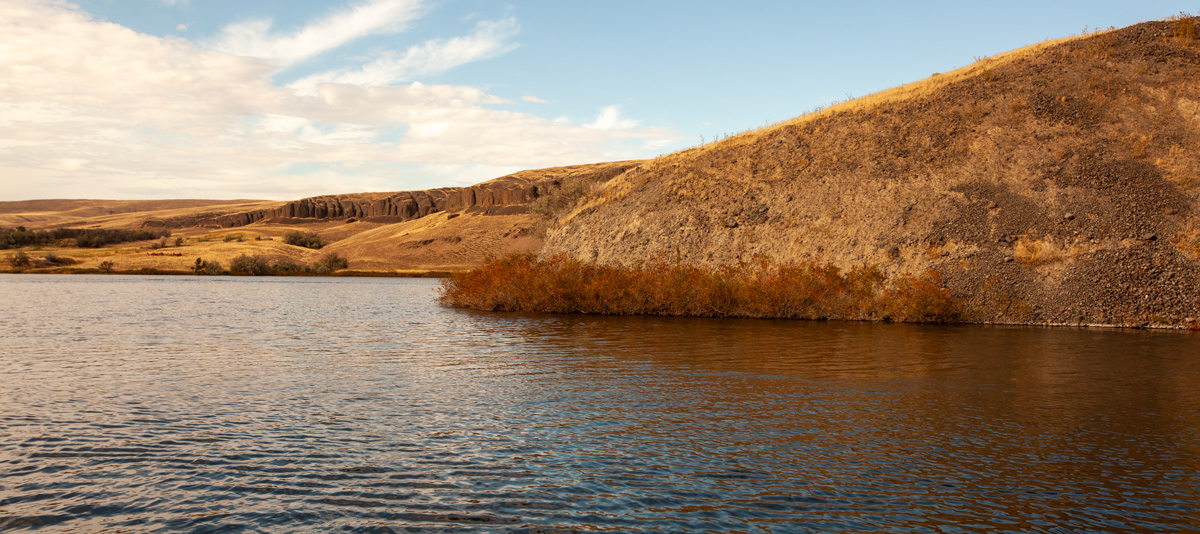Riparia, WA The paddlers find good water on the Snake River and make about thirty miles before stopping at a long rapid at present-day Riparia. They describe Palouse villages and find that Sacagawea “reconsiles all the Indians, as to our friendly intentions.”
Snake River near Riparia
© 4 October 2014 by Kristopher K. Townsend. Permission to use granted under the Creative Commons Attribution-Share Alike 4.0 International license.
Above: The rapids and stony islands have been tamed by modern dams, but the small willows and basalt rocks survive. See “Taming Rocky Rivers” in Monumental Rock.
Warning of Bad Rapids[1]Originally aired weekdays by Yellowstone Public Radio during the Bicentennial observance of 2003-2006. Narrated by Hal Hansen. Scripts by Whit Hansen and Ed Jacobson. Produced by Leni Holliman. © … Continue reading
Palouse Villages
Some of the Flathead nation of Indians live all along the river this far down. There are not more than 4 lodges in a place or village, and these small camps or villages are 8 or 10 miles apart: at each camp there are 5 or 6 small canoes. Their summer lodges are made of willows and flags, and their winter lodges of split pine, almost like rails, which they bring down on rafts to this part of the river where there is no timber.
—Patrick Gass
Morning Shopping
after purchaseing every Speces of the provisions those Indians could Spare we Set out and proceeded on
—William Clark
Passing Stony Islands
we passed Several Stoney Islands today Country as yesterday open plains, no timber of any kind a fiew Hack berry bushes & willows excepted, and but few drift trees to be found So that fire wood is verry Scerce— The hills or assents from the water is faced with a dark ruged Stone.
—William Clark
Scarce Wood
the current Swift in Some places, but gentle in general. about 12 oClock we halted to dine on the Lard. Shore. could Scarsely find wood enofe to cook our victules.
—Joseph Whitehouse
Noon Observation
Captain Lewis took at this place a Meridian Observation and found this place to lay in Latitude 46° 29′ 21 7/10S. North.
—Joseph Whitehouse
Rapid near Riparia
we found [this rapid] long and dangerous about 2 miles in length, and maney turns necessary to Stear Clare of the rocks, which appeared to be in every direction. The Indians went through & our Small Canoe followed them, as it was late we deturmined to camp above untill the morning.
—William Clark
Token of Peace
The wife of Shabono [Charbonneau] our interpetr we find reconsiles all the Indians, as to our friendly intentions a woman with a party of men is a token of peace
—William Clark
Weather Diary
Day of the month Wind State of the Weather 12th E & S W fair Note from the 7th to the 16th octr. we were decending Kooskooske [Clearwater] & Lewises [Snake] river
—William Clark[2]Some abbreviations have been spelled out.
Notes
| ↑1 | Originally aired weekdays by Yellowstone Public Radio during the Bicentennial observance of 2003-2006. Narrated by Hal Hansen. Scripts by Whit Hansen and Ed Jacobson. Produced by Leni Holliman. © 2003 by Yellowstone Public Radio. |
|---|---|
| ↑2 | Some abbreviations have been spelled out. |

